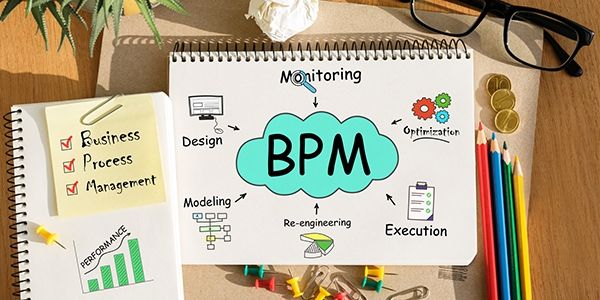
Business Process Modeling
A Business Analyst is the core member of the project team. He is a star of any project. He is a friend of business.
He resolves complexity. He offers solution. He mitigates risk. He delivers value to the customer. In any project a ‘Value’ can be defined by two aspects –
Value is
- fit for purpose (is the value delivered satisfies the business need?)
- fit for use (is the value delivered correct?)
But delivering value to any stakeholder is not an easy task though. However a BA can build and maintain trust by delivering ‘work samples’ to stakeholders. Here work samples can be referred to any screenshot of the working product or it could be a trial version et cetra. A BA should be vendor neutral in order to maintain transparency among other team members and stakeholders.
In other words a BA should model the requirements and should model the process. How the process works in an organization and what needs to be done to improve the current process. Thus, a concept of Business Process Modelling (BPM) came into existence. Let’s try to figure out BPM.
BUSINESS PROCESS MODELING
Business process modeling (BPM) in systems engineering is the activity of representing processes of an enterprise, so that the current process may be analyzed or improved.
It is performed by –
- Business Analyst
- Subject Matter expert (SME)
- a team comprising both
(source – Wikipedia.org)
First we need to understand what a process is. A process is flow of events that occur in any business to gain monetary benefits without considering risk and losses. These risk and losses are not owned by the stakeholders. To model these processes for the benefit of business needs is a prime responsibility of a BA. Thus we can summarize by the figure that follows.
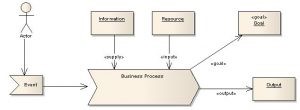
You can see that in a business process which is triggered by some business event has inputs like resource and information which gives rise to certain requirements. An actor could be anyone that initiates the business event which realizes the need of something. It could also be an issue that gives rise to the need to either improvise the current process or improve it. A business process should then satisfies the goals and some output which offers value to the stakeholders.
In other words, a Business Process Modeling is a set of activities that describe the order of activities from start to finish with some input and some output correspondingly. A BA can consider the business process model is the final output to meet business needs.
Components of Business Processing model includes –
- a goal – every business process has a number of goals to achieve, these goals need to be able to meet business needs
- input – input could be use case stories, product backlogs, requirements which are elicited, analyzed and validated
- Message (information) – messages are used to complete the activity. In the business process, the message is not consumed, but as part of conversion process. There are various sources from where the messages are generated for instance, external resources, customers, internal organizational units and even other processes.
- Resources – it can includes the staff, the machines and other architecture. Unlike the message, the resource is consumed and could be exhausted.
- Output – each business process generates some outputs that meets the business needs. The output could be either physical object (for instance, a report or an invoice) or it can be the end of the entire business process.
In modelling language, the stakeholders are referred to as the actors. They can be a person, department, system, or an external entity to the organization. Few are the benefits of Business Process Modelling –
- Ensures you understand how an organization runs & performs activities, and relates to the outside world
- Identifies areas that are not well understood
- Helps identify complex business processes
- Helps with the training documentation
BPM Tools
There are 4 different types of tools used in Business Process Modelling –
- Context Diagram – These are the high level framework of the interaction of the organization with external entities. Below is the sample context diagram :
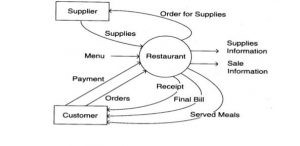 a typical contextual diagram
a typical contextual diagram
It represents the flow of events with supplier and customer as an external entity. It illustrates the interaction of these entities with the restaurant. - Functional flow diagram – It is a step by step process which depicts the system’s operational flow. Also referred as block diagram. Below is the sample one indicating process step by step –
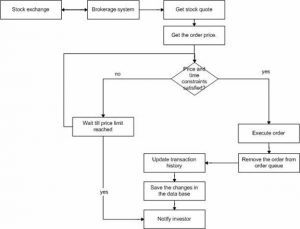 functional flow depicting each flows
functional flow depicting each flows
We can see all the possibilities and assumptions have been considered in functional flow diagram. It could be under same department or multiple. But the separation can’t be seen. - Cross Functional flow diagram – Process flows are segregated within different aspects. Here it could be different departments or operations. In manufacturing industries the design department is different, assembling department is a separate entity and finally the testing department is altogether one. But the process flows are interconnected between all these different departments. Have a look at the below sample –
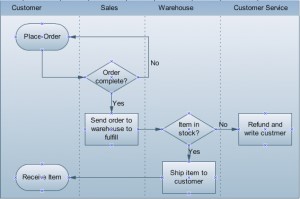
Cross functional-purchasing item sample
Here you can see processes are been transitioned from customer to sales department. The sales department contacting the warehouse for checking the availability of item and finally customer service for after sales support. Also referred to as ‘Activity Diagram’ and ‘Swim-lane Diagrams’. - Use Case diagrams – These are the user perspective modelling diagrams used to model the interaction of the user (actor) and secondary actor with the system. It represents only positive flows, no if-else statements and no negative flows. It is one of the most important tool for Business process modelling. Elements of Use Case diagrams include Actor (Primary/Secondary), use case(s), association, system boundary, system clock. Below is the sample-
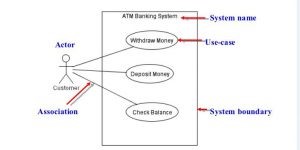
use case-sample
Here a customer (actor) using ATM banking system (System boundary) for withdrawing, depositing money and checking balance (use cases).
A BA should note that he should use BPM tools to model the requirements. Thus modeling approaches should be
- easy to read
- capture the processes
- be a foundation for other models
- should represent the current state
The way to create effective models is to train the modelers ,explain modeling to business attendees (stakeholders or business sponsors) and check if work has already been done and starting with the known and then integrating details into the current one. This leads to another important aspect for BA which is ‘Change Request Management’.
buy blue meanie magic mushroom
… [Trackback]
[…] Here you will find 18854 more Info to that Topic: batimes.com/articles/business-process-modeling/ […]